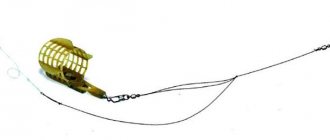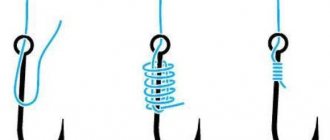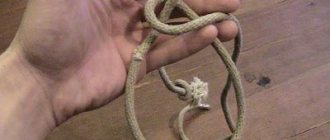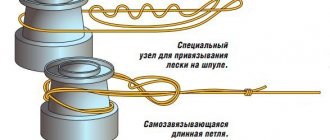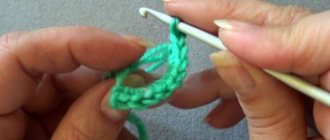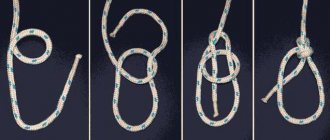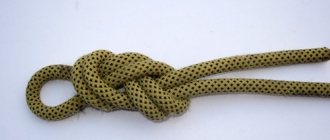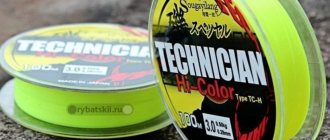Feeder fishing has already firmly occupied its niche in the society of fishermen around the world and is widely popular among them. It is not surprising that the development of skill and perfection in this area of fishing art leads to the invention of new types of equipment, complicating their installation.
As most anglers know, the design of feeder rigs is based on loop tying. Additional elements are mounted in the loops, allowing you to equip the installation with leashes, feeders, and secure it to the main cord of the tackle. In many design options for feeder equipment, the asymmetrical loop for the feeder stands out in a special way.
The concept of an asymmetrical loop when fishing with feeders
Not every angler will call this type of equipment simple to implement and universal to use in practice. This impression was formed due to a misunderstanding of the essence of the operation of the equipment, as a result of which the distribution of this design among a wide range of feeder lovers did not receive sufficient recognition and practical application. But in vain.
The principle of operation of this loop is based on the difference in the length of the arm of the main loop in relation to smaller fastening loops, which are located opposite each other. The longer arm is intended for mounting the feeder, and the short one is for transmitting the bite signal to the quivertip of the rod. I agree that there are difficulties in the implementation of the equipment, but they are not so difficult as to completely abandon the use of this type of installation. Most likely, in fishing conditions, trying to verify all the sizes is quite problematic due to the lack of time, but at home, spending two hours to prepare several ideal options for an asymmetrical loop, if desired, you can always find. And the time spent, with a high probability, will be well spent and will prove this by the effectiveness of fishing, while some fishermen in the neighborhood will not even see the smallest bite throughout the entire fishing.
Further, as the article progresses, I will try to clearly reveal all the secrets of knitting an asymmetrical loop for the feeder and its equipment, as well as the nuances of the proportional relationships between the elements of the equipment and point out the advantages of this installation under certain fishing conditions.
Asymmetrical loop
The asymmetrical loop has high useful characteristics, due to which it is often compared to a paternoster. Both of these types of gear are effective for fishing, they are distinguished by their level of sensitivity, ease of manufacture and ease of use.
An asymmetrical loop has a number of advantages:
- Good flight performance;
- Using such a loop allows you to keep the leash untangled while fishing, so you don’t have to waste time untangling it;
- The tackle has a self-cutting effect.
The asymmetrical hinge is a modernized version of the symmetrical hinge. The difference between them is that the latter has identical fields in relation to the horizontal axis, while in an asymmetrical loop one of these fields will be larger than the other.
A symmetrical loop is less sensitive, in addition, such a location of the feeder will seriously dampen vibrations. As a result, an uncertain fish bite can be missed. When using an asymmetrical loop, even a slight vibration of the leash and feeder will be transmitted to the rod.
How to choose fishing line
Important! This equipment works most effectively when used as a basis for tying lines with no memory and a high coefficient of rigidity.
Fluorocarbon representatives with a diameter of 0.25-0.30 mm are an ideal option . Modern fishing lines of this series have a high degree of transparency and excellent abrasion resistance characteristics, which meets the necessary requirements for feeder fishing. After all, shell rock, coarse sand and pebbles of various fractions at the bottom of a reservoir are not uncommon, and, in principle, a favorite feeding place for fish.
Also an important factor in the use of these fishing lines is the ability to maintain high strength in places where knots are tied, which is not always the case with conventional monofilament fishing line of the same diameter. Installation from such a cut of fishing line will be durable, invisible in the water and have the least shock-absorbing properties.
How to tie an asymmetrical loop for a feeder
To create an asymmetrical loop, we need 1-1.5 meters of rigid fishing line with a cross-section of 0.25-0.35 mm. It's probably better to use fluorocarbon. This line has good abrasion resistance and is really tough.
We fold a piece of fishing line so that one half is 10 cm longer than the second. Insert a pencil or finger into the loop that separates the two parts of the fishing line. We hold two ends in one hand, and with the other we wind a branch 8-10 cm long. We knit a loop for leashes at its end. At the second end of the bend we make a knot that will prevent the twist from coming apart. The tighter the twist, the less likely it is that the mounting hooks will overlap with the main line. After this, cut off the end of the fishing line, which is located near the loop. We attach a swivel with a carabiner or a clasp to the second end.
The length of the loop varies between 30 and 70 cm. These installations are best stored in small plastic bags.
How to knit an asymmetrical loop
Don’t be too upset if your first practical knitting experience isn’t entirely successful. An asymmetrical loop for a feeder is indeed not the simplest element in feeder equipment, which is worth considering. There is no need to rush in this matter, since all the nuances of the work discussed below must be extremely consistent in size and elements.
A meter-long piece of fishing line is folded exactly in half and the first small loop is knitted at the place of the fold to install the leash. A variant of the loop knot is up to the angler to choose, the main thing is that the loop is blind. The next element will be the twist. Its size should not exceed ten centimeters. This size must be observed. Twisting to a lesser extent will not particularly affect the performance of the installation, but a longer element will periodically be the culprit for tangling the feeder loop. The finished twist in the same dimensions is tied with a knot. The easiest and fastest way is eight. Now let's move on to the main part of the work, which contains the main purpose of this design.
Important! We tie the two remaining tails of the fishing line so that one of them is only two centimeters longer than the second. This difference in size is asymmetry.
We finish the knitting again with a blind loop, which will serve as a connecting element to the main cord of the tackle. The installation is now complete. As can be seen from the description, with care and accuracy, the asymmetrical loop is not so scary, but quite effective, and this is what we will talk about next.
Installation
An asymmetrical loop for the feeder is knitted on a separate fishing line and attached to the main one using a swivel.
The fishing line is folded so that one half is longer than the other by about 15 cm and a loop is tied for the leash with a hook, which is secured with a double or triple knot. Then on one of the sides, 15 cm away from the end, a branch leash is knitted. It should be rigid - this will not allow the loop to get tangled when casting the tackle.
For a retractable leash, a twist is knitted (length 10 cm). The fishing line is bent in half and scrolled, leaving a loop on top (1-2 cm). To secure the twist, a double knot is tied at the base and end. When finished, you get a large loop 50 cm long, with a small loop on the side.
To attach the feeder, a swivel (carabiner) is threaded through the side of the longer half. The feeder moves freely from the base to the twist. A leash is attached to a small loop using a swivel. The remaining ends of the fishing line are cut so that the tackle does not get tangled.
Advantages and disadvantages of equipment
So that it does not seem that this equipment is a complete panacea for lack of bite, let’s start with some of the existing disadvantages of this installation option. As already mentioned, the main negative factor is the labor intensity in knitting a loop, this is especially noticeable in comparison with the production of a symmetrical loop for a feeder. Even with correctly connected elements, tangling of the equipment is common, which is caused by careless casting. The equipment requires an additional fastener, which serves to connect with the main cord, since the installation is knitted separately from the main thread. The angler is required to constantly monitor the gear, since self-hatching of the fish is practically eliminated. Well, now about the sweet stuff - about the advantages of this equipment.
Important! The fundamental advantage is the sensitivity of the gear to bites and, what is very important, even the smallest ones.
The feeder is located on the long arm of the loop, having a handicap over the short arm of 20 mm, allowing the tip of the rod to instantly accept any touches of the fish to the bait, which are perceived and transmitted to the tackle by the short arm of the loop. With such equipment, the use of light feeders and thin leashes is justified, especially in standing reservoirs, without fear of fish breaks, because the equipment is always under supervision. With passive biting, asymmetry is a salvation from a zero outcome of fishing.
Advantages and disadvantages
Despite all the difficulties, the asymmetrical loop has both advantages and disadvantages, and is one of the basic equipment, so any fisherman should be able to knit it and use it in suitable situations.
Advantages of an asymmetrical loop for a feeder:
- High sensitivity. Allows you to feel the most accurate fish bites.
- Suitable for fishing in strong currents, as it allows you to hook fish yourself.
- The long leash of the tackle helps the fish to bite and move independently without feeling any danger.
- Suitable for passive fish and in pressurized reservoirs.
- The feeder and leash do not get confused with each other.
Using an asymmetrical loop
Often, when fishing with a feeder, the angler, without waiting for a bite signal, begins to check the bait and discovers that it is slightly tattered or that a moth or some small component of the bait is missing. If such cases are repeated repeatedly, this is a clear sign of fish passivity. The fish touches the bait, but the weight of the feeder and the lack of timely hooking, because the angler does not see or hear it, deprive the joy of catching trophies. This situation is the moment of using an asymmetrical loop.
Read a complete guide for beginners about catching bream on a feeder and preparing equipment, as well as choosing bait and bait.
The thinness of the equipment will allow you to respond in a timely manner to the lethargy of the fish and catch it. When the bite is active, feel free to switch to installations with the possibility of self-hooking, because with this installation, an asymmetrical loop, the fisherman will simply get tired of constant sharp bites and labor-intensive hooking of fish.
How to knit an asymmetrical loop
We knit the loop in several stages:
- We take 60-70 cm of fishing line, fold it in half and make a small loop to connect to the leash. The loop knot can be made using a regular double knot or a figure eight knot.
- Next, we twist the two lines and secure it with a knot as well. Twist length 10-15 cm.
- We get a twist and two pieces of fishing line. We pass a swivel with a carbine through one end of the fishing line. The carabiner should be used without protruding parts of the “antennae” to minimize snags.
- Now we make the end of the line with the carabiner 2 cm longer than the second end of the line, as shown in the diagram.
- We measure the length of the loop to 10-15 cm and tie a locking knot.
- At a distance of 2-3 cm from the last knot, we knit a loop to attach to the main fishing line.
We get the following installation of an asymmetrical loop for the feeder:
Now about the geometry of the loop, the sizes of its elements and their proportions.
When the loop is ready, the outlet leash should be at least 2 cm below the feeder!
With this difference, there will be a minimum of tangles and overlaps between the leash and the feeder.
The difference in the loop arms (overhang) should not be more than 2 cm!
If this difference is greater, then the sensitivity of the loop decreases and careful bites may simply not be noticed.
How to knit an asymmetrical loop for a feeder, its features and advantages
The asymmetrical loop for the feeder is known to many fishing enthusiasts. Unlike the paternoster, this equipment is more complex, so it often doesn’t take root with novice feeders due to constant tangling, breaks and shooting. This is where most fishermen dislike it.
The asymmetrical loop came to us from Europe, like most equipment and methods of feeder fishing. The first to test it were Dutch fishermen, who caught bream in this way on many rivers and at the same time showed excellent results.
